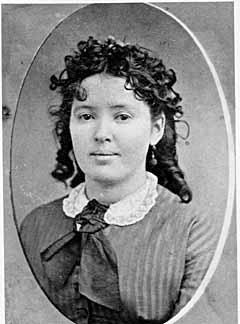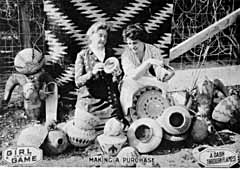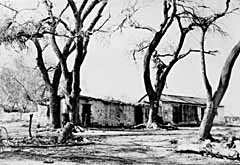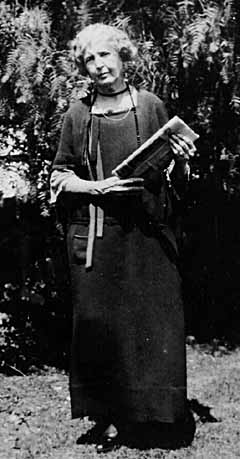Helen Stewart
Hot, sore and covered in dust, Archie Stewart pulled the freight wagon into the shade of the cottonwood trees on that blistering July day in 1884.
He had been away from the Las Vegas Ranch for several days, delivering produce and livestock to hungry miners in Eldorado Canyon. A couple of his hired men approached and began to unhitch the tired team. Stewart jumped down, slapping the dust off his pants legs, wiping his face and neck with his bandana, walking to the house.
His wife, Helen, was inside, still trying to decide how to tell her husband about the unsettling incident that had occurred a few days earlier.
A ranch hand, Schyler Henry, had abruptly announced he was quitting. He went to Helen Stewart demanding his wages. She refused, explaining that she did not know how much he was owed, and that he would have to wait until Archie Stewart returned. Henry blustered, threatened, and insulted Helen Stewart, but she held firm.
It is unknown exactly what Schyler Henry said to Helen Stewart. She never repeated it, except to remark that the ranch hand owned a "black-hearted slanderer's tongue."
But it was sufficiently provocative that Archibald Stewart, after a short rest and a meal, saddled a horse, put his rifle in its scabbard and rode off for the Kiel Ranch, near the present location of Carey Avenue and Losee Road in North Las Vegas. The spread was operated by Conrad Kiel and his son, Edwin.
The ranch had a well-deserved reputation as a haven and hangout for various badmen, outlaws and scoundrels, men like Hank Parrish and Jack Longstreet.
When Archie Stewart arrived at the ranch, he tied his horse to a tree behind a growth of grapevines, and walked slowly to the back of the house. All the doors and windows of the house were open, and Archie Stewart was spotted. He evidently fired the first shot, and missed. A short firefight ensued, and when it was over, Stewart was dead with wounds in the chest and head. Schyler Henry received two flesh wounds.
At first, the killing was credited solely to Hank Parrish, who promptly disappeared. Conrad Kiel and Schyler Henry were hauled before a grand jury in Pioche. The jury declined to indict. As for Parrish, he was later tried and hanged in Ely for the last in a long line of murders.
The case remains unsolved to this day. But Helen Stewart believed for the rest of her life that the Kiels, Henry and Parrish all had a part in her husband's death, and that the whole drama between her and Henry had been a ruse concocted to lure her husband to the ranch and kill him.
Helen Stewart believed that the conspiracy was hatched by Parrish. A year before he was killed, somebody stole two of Archie Stewart's horses. He followed and recovered the horses, but the thief escaped. Stewart also found some stolen cattle belonging to an acquaintance in Pahranagat Valley. Parrish, the supposed thief, sent word to Stewart that he would kill him.
No sooner had the smoke cleared from the shootout than Conrad Kiel dispatched a rider with a rude note for Helen Stewart.
"Mrs Sturd send a team and take Mr. Sturd away he is dead. C. Kiel."
Helen Stewart went to the ranch herself and helped to load her husband's body. Archibald Stewart was buried the next day, the first of seven people who would be interred in a four-acre family plot.
And she was on her own. She had four minor children, another on the way, a crop of peaches that needed to be picked, and travelers arriving each day in need of food, water and rest. She would shortly face major legal problems because Archie had failed to leave a will.
Helen Stewart had always despised the isolated ranch life, and had only agreed to move to the Las Vegas Ranch when her husband promised her it would be only a temporary stop. Instead, she would spend the next 20 years running the place, improving it, constructing what would become the nucleus of a great Western city.
The woman who became known as "The First Lady of Las Vegas" was born Helen Jane Wiser on April 16, 1854, in Springfield, Ill. When she was 9, her parents took their five children West, stopping for a short time in the Carson Valley of northwestern Nevada, before continuing on to Sacramento, Calif. Helen attended Sacramento public schools and Woodland College in Yolo County. At age 18, she married 38-year-old Archibald Stewart. The newlyweds were then off for Lincoln County, where Archie Stewart had been running a freighting business since 1868. He also had a ranch near Pioche, where he raised cattle and vegetables. He had wisely combined his ranching and freighting operations, so when the inevitable boom and bust cycles rolled through the Pioche mines, he was able to prosper by hauling his goods as far north as Eureka and as far south as Eldorado Canyon.
By 1876, the Stewarts, now with sons William James and Hiram Richard, had moved into Pioche, much to the delight of Helen Stewart, who yearned for a social life. In 1879, Archibald Stewart purchased another local ranch, and he also made a loan which changed the course of Nevada history.
Octavius Decatur Gass had developed a marginally successful ranching and farming operation around the abandoned Mormon Fort that had been built in 1855 near what is today the intersection of Las Vegas Boulevard North and Washington Avenue. But the Mojave Desert environment was unpredictable, some years producing phenomenal crops, in other years, practically nothing. Gass, who was really more interested in mining than ranching, had been sliding into debt and, in August 1879, he persuaded Stewart to loan him $5,000 in gold at 2.5 percent interest per month, payable in one year.
Gass had been trying to sell the place since 1868, and may have had no intention of paying back the debt. He was angry with the state of Nevada for taking his part of the world away from Arizona Territory and making it part of Nevada. Gass had lost the prestige of being an Arizona Territorial legislator and, to add injury to insult, had received a huge tax bill from Nevada's Lincoln County. O.D. Gass may have simply decided he would sign the promissory note to Stewart, take the money and run.
Which is how, in 1880, Stewart acquired the 960-acre ranch and set about doing what no one had done before -- making it profitable.
He told Helen he planned to move the family to Las Vegas. She was horrified. She was pregnant, frightened at the prospect of having the child without another woman in attendance, and was concerned about the lack of educational opportunities for her sons. Archie soothed her, saying it was to be only a temporary move.
The Stewarts' trip, in 1882, took nearly a week, and there was plenty to do when they arrived. Helen gave birth to her second daughter, Evaline La Vega, who derived her middle name from her place of birth.
Helen Stewart seems to have found life at the ranch less isolated and lonely than at the Pioche place, mostly because of the nonstop flow of travelers. Often, the Stewarts would awake to find dozens of travelers camped on their property. In her biography of Helen Stewart, published in the Nevada Historical Society Quarterly, Carrie Miller Townley noted, "When the arriving group contained women, Helen Stewart was especially happy, as she hungered for feminine companionship."
The ranch, with its cool creek and huge, shady cottonwood trees, was a resort for heat-weary miners from Eldorado Canyon. In a good year, the ranch's vines could produce as much of 600 gallons of serviceable wine, and the Stewarts sold it cheap. A writer in 1883 reported many of the prospectors in Eldorado Canyon had "all quit work for some time and are rusticating up at the Vegas Ranch, having a jolly time drinking wine. Whenever any of them get drunk, they are placed in the works of the roots of a tree and made to sit there until sobered."
In 1885, the probate was finalized, and Stewart wound up owning half the ranch. The other half was divided among the five children, Will, Hiram, Eliza (Tiza), Evaline and the baby, Archibald.
As administratrix of her children's affairs, she sought permission from the court to sell the entire ranch, arguing that if they were forced to grow up there they would be deprived of proper education. The request was granted. Prospective buyers came to look at the ranch in 1887 and 1889. But even though Archibald Stewart had turned down $11,000 for the place a couple of years after acquiring it, his wife had no such luck.
But in 1889, land speculation fever struck the Las Vegas Valley and the Muddy River region as word began to circulate that plans were in the works for a railroad.
Helen Stewart began to buy land, and her father and sisters began to do likewise along the Muddy River. She made a deal with her father and brother-in-law to loan them 100 head of cattle.
Stewart's education dilemma was solved by the arrival of elderly James Ross Megarrigle, who had been in Lincoln County for the previous 20 years. A graduate of Oxford, Megarrigle was a teacher by profession, but was also a writer, poet, orator and could play a passable fiddle. Despite her rustic circumstances, Helen Stewart loved the life of the mind, and found in Megarrigle a mentor and the sort of friend for which she longed.
By agreeing to tutor the Stewart children, the itinerant pedagogue had finally found a permanent home, and the distinction of becoming the first teacher in the Las Vegas School District for Lincoln County. The girls were amenable to learning, but Will and Hiram had already become seasoned ranchers, and saw "book learning" as a waste of time.
In 1894, Megarrigle became ill with influenza, died, and became the second person to be buried in the four-acre cemetery.
But he wasn't the only man to find a permanent home at the Stewart Ranch. In 1886, Frank Roger Stewart, no relation to Archibald, arrived from Sandy Valley, where he and a partner had operated a store and post office.
He proved an unusually valuable ranch hand.
He was also a convivial host, and visitors observed that he spent a great deal of time in the wine cellar, entertaining travelers with wine and wit.
Helen Stewart and Frank Stewart had a close relationship, based originally on his value as an employee. It evolved into something deeper, and by 1903, into marriage.
Because of its location, the Las Vegas Ranch had long been a message center for the region. Travelers routinely left messages for those coming behind them, and the few settlers in the area constantly left notes and letters with Helen Stewart. In June 1893, Stewart was named postmaster of the "Los Vegas" post office. Authorities insisted on the incorrect spelling for fear of confusing the office with Las Vegas, N.M.
Megarrigle's death had rekindled Helen Stewart's anxiety about her children's education. Even with a new teacher's arrival, Stewart decided that the best way to ensure a quality education for her three daughters, and her youngest boy, little Archibald, would be to pack them off to boarding school in California.
Will and Hiram, having reached adulthood, split the ranch duties. Hiram handled most of the livestock operation and married the new schoolteacher at the ranch in 1896. Will tended to the crops and became involved in civic duties.
In Los Angeles, the girls were happily ensconced at the boarding school, but 12-year-old Archie was feeling abandoned and homesick. He was picked up by Pasadena police with one penny in his pocket. At the station, he told the cops, and subsequently news reporters, that he was planning to walk to his mother's ranch in Nevada. The story of the plucky little kid who planned a solo hike across the Mojave Desert was duly reported in the Los Angeles press. (Further investigation revealed that he had simply taken a ride downtown with a family friend and become separated, but took the opportunity to pull a few legs by embellishing his story.)
The incident scared and sobered young Archibald, and he promised to tend his studies and cause no more trouble.
Helen Stewart doted on the boy, who had never met his father, and constantly wrote him, sometimes in verse, urging him to excel:
Dare to do right,
Dare to be true,
Dare to do good
Everything will come right for you.
But it didn't. In July 1899, Archie was chasing wild horses at the ranch. He fell from his own horse, and was killed. His mother took the news harder than she had taken even that of her husband. In a tear-stained letter to Tiza, her eldest daughter, Stewart remembered what would have been the boy's birthday:
"Today Archie would have been 15 years old. I have cried most all day through my work and all. I have had a dreadful time bringing myself to submit to what I know must be. I needed him so much."
Talk of a railroad through the valley continued, but railroad magnates were concerned about rapidly inflating land prices and excessive speculation. Even so, early negotiations between local landowners -- including Stewart -- and W.H. Bancroft of the Oregon Short Line Railroad Company had begun by 1901. But the OSLRR failed to exercise its option and lost it.
So, in 1902, Stewart signed a contract that became the de facto birth certificate for the city of Las Vegas. The contract was with Sen. William A. Clark of Montana, and spelled out the terms for the sale of the Stewart Ranch to the San Pedro, Los Angeles and Salt Lake Railroad. The agreed price was $55,000, and did not include the "Four Acres" family cemetery, or a small allotment of water from Las Vegas Creek. The four remaining Stewart children deeded their shares of the ranch to their mother for $1 "and love and affection," though Hiram, who knew only the ranching life, gave up his interest reluctantly.
In 1902, Helen J. Stewart and family were out of the ranching business in Southern Nevada, though knowing of the railroad's plans for her ranch and the surrounding land, she snatched up another 924 acres, including a 40-acre plot adjacent to the "Four Acres," where she lived for the rest of her life. First, however, the family took a trip to Los Angeles.
It was there that Hiram Stewart, only two months after the sale, caught cold after going swimming. He died when it escalated into pneumonia. He was embalmed and shipped back to Las Vegas, where he was buried in the "Four Acres" between his younger brother Archie, and an Indian girl known as Nipe.
Will Stewart came back to Las Vegas in 1903 to supervise the building of the new house across the street from the old ranch. In 1905, the railroad auctioned 1,200 lots, creating the downtown core of Las Vegas which, of course, included a Stewart Street. She wrote:
"Following the trail of the trapper and of the trail blazer, and the pioneer, came the iron horse, that great annihilator of time and distance, bringing all the modern ideas of advanced civilization in our midst and we awoke as if in a dream and found all the comforts of an advanced civilization with us. The hardships were no more."
Although Las Vegas in the first decade of this century was hardly "an advanced civilization," it was all Helen Stewart had hoped for. Suddenly, there were other women in the new town. There was society, of sorts.
One of the earliest social butterflies to alight in Las Vegas was Mary Belle Viley Park, wife of dentist William S. Park. Mary Park was a product of Kentucky plantation society, and observed a well-defined code of social conduct. Twenty years of dealing with ranch hands, miners and Indians had taken some of the luster from Helen Stewart's social skills.
At a reception held by Mary Park, Helen stepped politely through the reception line, headed for the kitchen and found a rocking chair where she installed herself for the remainder of the afternoon. Mary Park was horrified, since genteel society prescribed precisely the amount of time a guest was to remain at a particular social function. Delphine Squires took Park aside and explained that in the world where Helen Stewart lived, guests stayed for days and weeks, not hours.
Stewart regained her polish, and soon became immersed in the social and cultural life of the fledgling town. She steadily acquired local artifacts ranging from old Spanish coins and jewelry to Indian crafts. Her basket collection was the finest in the state.
When Jeanne Elizabeth Weir, founder of the Nevada Historical Society, came to Southern Nevada in 1908, she sought out Helen Stewart. Before the visit had concluded, Stewart was president of the Southern Nevada branch.
There had always been a place for native people on the Stewart Ranch while Helen ran it. In 1911, the federal government decided to establish an Indian reservation in or around Las Vegas, and asked for bids for the land. Whether she donated the land, or was paid for it, is unclear. But it was she who provided the site for today's Las Vegas Paiute Indian Colony on North Main Street.
She became one of the state's foremost authorities on the history of Southern Nevada, and was a sought after speaker all over the state.
In 1915, she became the first woman elected to the Clark County School Board, and in 1916, the first woman to sit on a jury.
In 1914, Will Stewart's second wife, after a difficult delivery, gave birth to a daughter who they named Helen J. Stewart. They did not realize until later that the child was mentally retarded.
"The doting grandmother had a special love for this exceptional granddaughter, and took great pleasure in each small, slow step forward the child took," wrote Townley. The Helen J. Stewart School, she notes, was named for the granddaughter, not the famous grandmother.
In 1925, Gov. James Scrugham wrote to Stewart asking her to display her baskets at the 1926 State Exposition in Reno. He suggested that the Legislature might be willing to pay a modest sum for the collection. She agreed to take her collection to the exhibition, and to make arrangements for it to be handed over to the state.
But before the plans could be finalized, Helen Stewart died of cancer on March 6, 1926. The loss of a great pioneer woman was bad enough, and it was aggravated by the fact that her executors sold her treasured basket collection at auction the following year.
Her funeral was one of the largest the city had seen. Mourners from all over the state paid homage to the legendary lady who had wrung a living from a harsh land, suffered hardships modern people cannot imagine, and ultimately prevailed. She was interred in a special vault hammered out of caliche on her "Four Acres." In the 1970s, the burial plot was purchased by Bunker Brothers Mortuary, which owned the adjacent land. The remains of Archie and Helen Stewart, as well as sons Hiram and Will, are now in Bunker's Eden Vale Mausoleum, a stone's throw from the site of the old home place.
"If any woman ever tackled the world by herself," wrote Townley, "That woman was Helen J. Stewart."




















